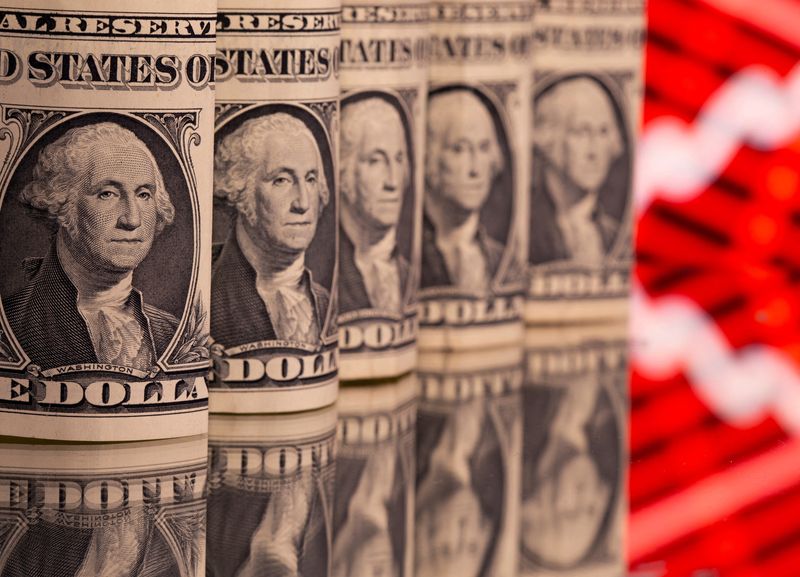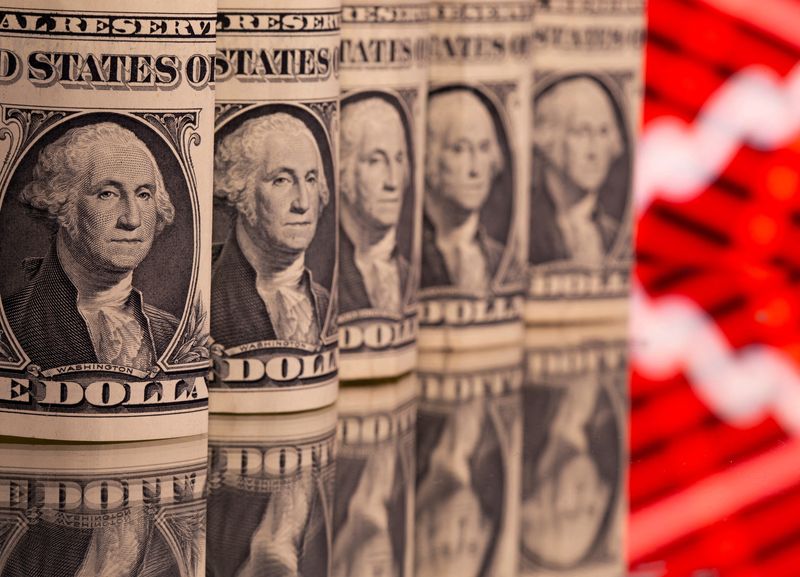Forex
Analysis-Dollar’s rally supercharged by diverging US rate outlook

By Saqib Iqbal Ahmed and Laura Matthews
(Reuters) – A rally in the U.S. dollar is accelerating, as stubborn inflation sows doubts over how aggressively the Federal Reserve will be able to cut rates this year compared to other central banks.
The , which measures the greenback against a basket of six major currencies, is up 4.6% this year and stands near its highest levels since early November. The index rose 1.7% last week, its biggest weekly gain since September 2022.
The greenback is advancing as market participants grow convinced the Fed will need to leave interest rates at current levels for longer to avoid a potential resurgence of inflation. Last week’s stronger-than-expected consumer price data bolstered that view: investors late Friday were pricing in just 50 basis points of interest rate cuts in 2024, futures markets showed, compared to 150 basis points priced in at the start of the year.
By contrast, investors believe some global central banks – including the European Central Bank, the Bank of Canada and Sweden’s Riksbank – could have a freer hand to ease monetary policy. That is a shift from a few months ago, when many believed the Fed would be among the first to cut rates.
“We had a fairly clear path that the Fed would likely be the first actor. The data that we have received really does undermine that,” said Eric Leve, chief investment officer at wealth and investment management firm Bailard. “I can see obvious reasons why the dollar could strengthen further.”
Yield differentials between the U.S. and other economies have widened in recent weeks, contributing to the greenback’s rally as higher yields boost the allure of dollar-denominated assets. The two-year U.S.-German bond spread stood at its widest since 2022 late Friday, LSEG data showed, a day after the European Central Bank signaled it could cut rates as soon as June.
Bullish investors have increased their bets on the dollar, while bears have wavered. Net bets on the dollar in futures markets stood at $17.74 billion in the latest week, data from the Commodity Futures Trading Commission showed, the highest level since August 2022.
Central bank policy has diverged in recent months, reflecting economies’ varying struggles to contain inflation.
The Swiss National Bank reduced rates by 25 bps in March, its first cut in nine years. Sweden’s central bank has signaled it could cut rates in May if inflation keeps falling, while the Bank of Canada recently suggested it was ready to ease.
Central banks in Australia, Britain and Norway, on the other hand, appear less eager to loosen monetary policy.
Japan’s yen, meanwhile, has weakened to a near 34-year low against the dollar – though the country has recently ended eight years of negative interest rates. The Bank of Japan has ruled out using rate hikes to support the currency.
Eric Merlis, managing director and co-head of global markets at Citizens, believes the dollar could continue appreciating broadly on the back of a more hawkish Fed relative to the ECB. The euro has fallen 3.6% against the greenback this year.
“The dollar has room to strengthen. We have the strongest economy right now, in general, the trajectory of yields has been going up,” he said. “Whereas Europe is struggling in terms of growth.”
A stronger dollar could complicate the inflation fight for other economies as it pushes down their currencies, while helping the U.S. tamp down consumer prices by tightening financial conditions.
Dollar strength can also be a headwind for U.S. multinationals as it makes it more expensive to convert their foreign profits into dollars, and make exporters’ products less competitive abroad.
Other factors may also be driving the dollar. The U.S. currency is a popular destination for investors during times of geopolitical uncertainty, which has sharpened in recent days on fears over a widening conflict in the Middle East.
Brian Liebovich, chief dealer for global foreign exchange at Northern Trust (NASDAQ:), believes the dollar may receive a boost from the Fed allowing assets to run off its balance sheet, a process known as quantitative tightening.
The Fed is currently allowing up to $60 billion per month in Treasury bonds and up to $35 billion per month in mortgage bonds to mature and not be replaced.
While Northern Trust expected the dollar to strengthen by up to 5% going into the U.S. presidential election, “market activity since the initial dollar rally this week suggests that move could happen sooner than expected,” Liebovich said.

Others are less certain the dollar has more room to run. Shaun Osborne, of Scotiabank, wrote that the dollar’s recent strength means investors have priced in a good deal of bullish news.
Rates and spreads are in the dollar’s favor, however, meaning “the trend at the moment suggests the USD will stay better supported,” he said.

 Forex3 years ago
Forex3 years agoForex Today: the dollar is gaining strength amid gloomy sentiment at the start of the Fed’s week

 Forex3 years ago
Forex3 years agoUnbiased review of Pocket Option broker

 Forex3 years ago
Forex3 years agoDollar to pound sterling exchange rate today: Pound plummeted to its lowest since 1985

 Forex3 years ago
Forex3 years agoHow is the Australian dollar doing today?

 Cryptocurrency3 years ago
Cryptocurrency3 years agoWhat happened in the crypto market – current events today

 World3 years ago
World3 years agoWhy are modern video games an art form?

 Commodities3 years ago
Commodities3 years agoCopper continues to fall in price on expectations of lower demand in China

 Economy3 years ago
Economy3 years agoCrude oil tankers double in price due to EU anti-Russian sanctions































